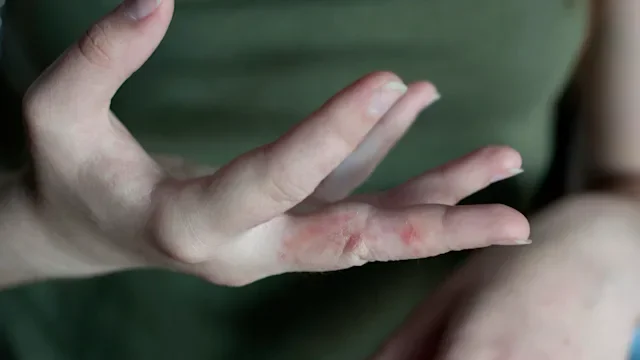Key takeaways:
Tinea capitis, or ringworm on the scalp, is a type of fungal infection.
Tinea capitis looks like a raised, red ring. It’s very itchy and can cause hair loss.
The treatment for tinea capitis includes antifungal medications that you take by mouth.
Save on related medications
Ringworm is a misleading name. A worm doesn’t actually cause it. The real offender is a fungus. The term “ringworm” comes from the fact that these fungal infections cause a ring-shaped, red rash.
The fungus that causes ringworm can infect your skin and nails. You can get ringworm on many parts of your body — like your feet (athlete’s foot) or your groin (jock itch). So, when you get ringworm on your scalp, it’s called “scalp ringworm” or tinea capitis.
If you’ve had ringworm somewhere on your body, you know that it can be very uncomfortable and itchy. The good news is that there are several things you can do to prevent it. And, if you think you may have it, we’ll also go over symptoms, so you can get treatment as soon as possible.
What causes ringworm on the scalp?
There are 40 species of fungus that can cause ringworm on the skin, scalp, and nails. The most common fungi that cause tinea capitis are Trichophyton and Microsporum.
Ringworm is very contagious. You can get it from:
Other people: If someone has ringworm and you come in contact with the area where the fungus is, you can pick it up. If you then touch or scratch your head, the fungus can get into your scalp.
Objects: You can pick up tinea capitis if you touch or use something that has the fungus on it. Common objects that spread tinea capitis include combs and brushes, hats, and helmets.
Pets: Animals can get ringworm, too. If your pet has ringworm and you touch them when playing or petting, you can pick up ringworm.
Yourself: If you already have ringworm on another part of your body, you can spread it to your scalp when you touch or scratch your head.
Children are more likely to get tinea capitis than adults. That’s because kids tend to wash their hands less often. They also tend to play closely with others, share objects, and touch their faces and heads more often than adults.
What are the symptoms of ringworm on the scalp?
There are four main symptoms of scalp ringworm:
Rash: Tinea capitis causes a rash on your scalp that looks like a raised, red ring. The skin in the center of the ring may look less red. It can take up to 2 weeks to develop the rash after coming in contact with the fungus.
Itching: The rash is usually itchy. The skin around the rash may also feel itchy.
Hair loss: Your hair may fall out or break off where you have the rash. If your hair breaks off close to your scalp, it may look like you have black dots on the rash. This is from your hair shafts peeking out of your scalp.
Swollen lymph nodes: You might also notice swollen lymph nodes on the back of your head or in your neck, which can be painful.
What does ringworm look like? Ringworm can look a little different depending on where it is on your body. These pictures can help you identify it.
Can your pet get ringworm? Yes, it’s possible. Here’s what to do if your cat or dog gets ringworm.
Not sure why your scalp is itchy? Learn about causes of scalp eczema and related conditions, so you can get to the bottom of the discomfort.
You can have one or more areas with tinea capitis on your scalp. That means you can develop a rash and hair loss on multiple parts of your scalp.
How is scalp ringworm diagnosed?
To diagnose tinea capitis, a healthcare professional will ask you about your symptoms and examine your scalp. To confirm a diagnosis, they may use a microscope to look at hair samples and scrapings from your scalp. But this isn’t always needed. A culture can confirm the type of fungal infection, though you’ll likely start treatment before getting the results. (Getting results can take 4 weeks.)
How do you treat scalp ringworm?
Scalp ringworm is different from other types of ringworm because it needs treatment with oral medication. You can treat other types of ringworm, like jock itch or athlete’s foot, with antifungal creams.
Read more like this
Explore these related articles, suggested for readers like you.
Griseofulvin is the most common medication for tinea capitis treatment.
Other medications you may use for tinea capitis treatment include:
Terbinafine (Lamisil)
You’ll need to take oral medication for 4 to 12 weeks to get the fungus out of your scalp.
Your healthcare professional might also recommend using antifungal shampoos, like selenium sulfide or ketoconazole. There’s some evidence that using these shampoos makes it harder for the fungus to spread to others.
You don’t need to shave your head or get a short haircut. This won’t help the fungal infection go away faster. It’s also safe to attend work or school while you have tinea capitis.
How long does it take for tinea capitis to go away?
Even with the right treatment, it can take weeks or even a few months for tinea capitis to go away. Most people’s hair does grow back, but it can take several weeks of treatment before you see any hair growth.
What can I do to prevent getting tinea capitis?
Getting rid of tinea capitis takes a lot of time and effort. It’s best to avoid getting it if you can. Here are some tips to keep in mind:
If you have ringworm: If you have ringworm or another type of fungal infection, like jock itch or athlete’s foot, try not to touch or scratch your scalp. Try to keep your ringworm covered with clothing or socks so you don’t touch it. Wash your hands often. Wash towels and clothing that comes in contact with the ringworm after each use. Get treatment for your ringworm as soon as possible.
If your pet has ringworm: See your pet’s vet right away if you think your pet could have ringworm. While your pet is getting treatment, wash your hands any time you touch your pet. Don’t let your pet sleep in your bed, and keep them off furniture until the rash is gone.
If a household member has ringworm: Don’t share items like clothing and towels with family and friends who have ringworm. If someone has tinea capitis, don’t borrow their brush, comb, hats, or headgear. Encourage everyone in your household to wash their hands often.
Frequently asked questions
Seborrheic dermatitis (dandruff) is one of several conditions that can be confused with tinea capitis. The biggest difference is that tinea capitis can lead to hair loss, but that’s not the case with seborrheic dermatitis. Also, with seborrheic dermatitis, you’ll likely notice more extensive scale or dandruff on your scalp and in your hair. Tinea capitis is known for a rash on the scalp that looks like a raised, red ring.
If you don’t treat scalp ringworm, your symptoms can get worse. You also run the risk of spreading it to other parts of your body and to others. Starting treatment early can help you avoid long-term complications, such as permanent hair loss.
Seborrheic dermatitis (dandruff) is one of several conditions that can be confused with tinea capitis. The biggest difference is that tinea capitis can lead to hair loss, but that’s not the case with seborrheic dermatitis. Also, with seborrheic dermatitis, you’ll likely notice more extensive scale or dandruff on your scalp and in your hair. Tinea capitis is known for a rash on the scalp that looks like a raised, red ring.
If you don’t treat scalp ringworm, your symptoms can get worse. You also run the risk of spreading it to other parts of your body and to others. Starting treatment early can help you avoid long-term complications, such as permanent hair loss.
The bottom line
Scalp ringworm (tinea capitis) is a fungal infection of the scalp that commonly affects children. It causes a red, scaly rash with the shape of a ring on the scalp. People with tinea capitis can experience scalp itching and hair loss.
Unlike other types of ringworm, the treatment for tinea capitis requires oral medication. So, if you notice signs of tinea capitis, schedule a visit to a healthcare professional. You may need to take medication for up to 12 weeks before the infection goes away.

Why trust our experts?



References
Aboud, A. M. A., et al. (2023). Tinea capitis. StatPearls.
Ali, S., et al. (2007). The assessment and management of tinea capitis in children. Pediatric Emergency Care.
Centers for Disease Control and Prevention. (2024). Clinical overview of ringworm and fungal nail infections.
Centers for Disease Control and Prevention. (2024). Symptoms of ringworm and fungal nail infections.
Ely, J. W., et al. (2014). Diagnosis and management of tinea infections. American Family Physician.
Gupta, A. K., et al. (2018). Tinea capitis in children: A systematic review of management. Journal of the European Academy of Dermatology and Venereology.
Oakley, A., et al. (2020). Tinea capitis. DermNet.


















